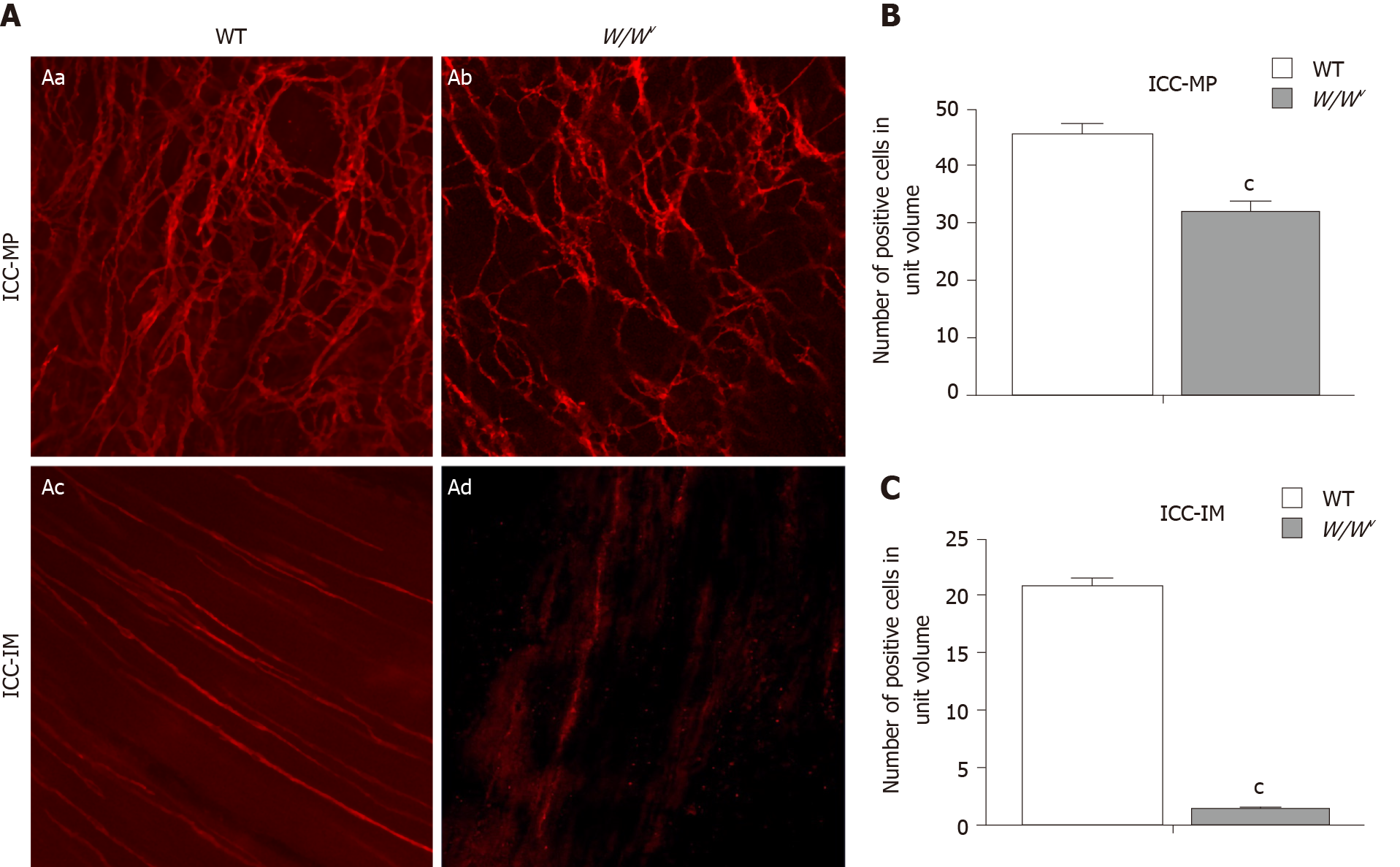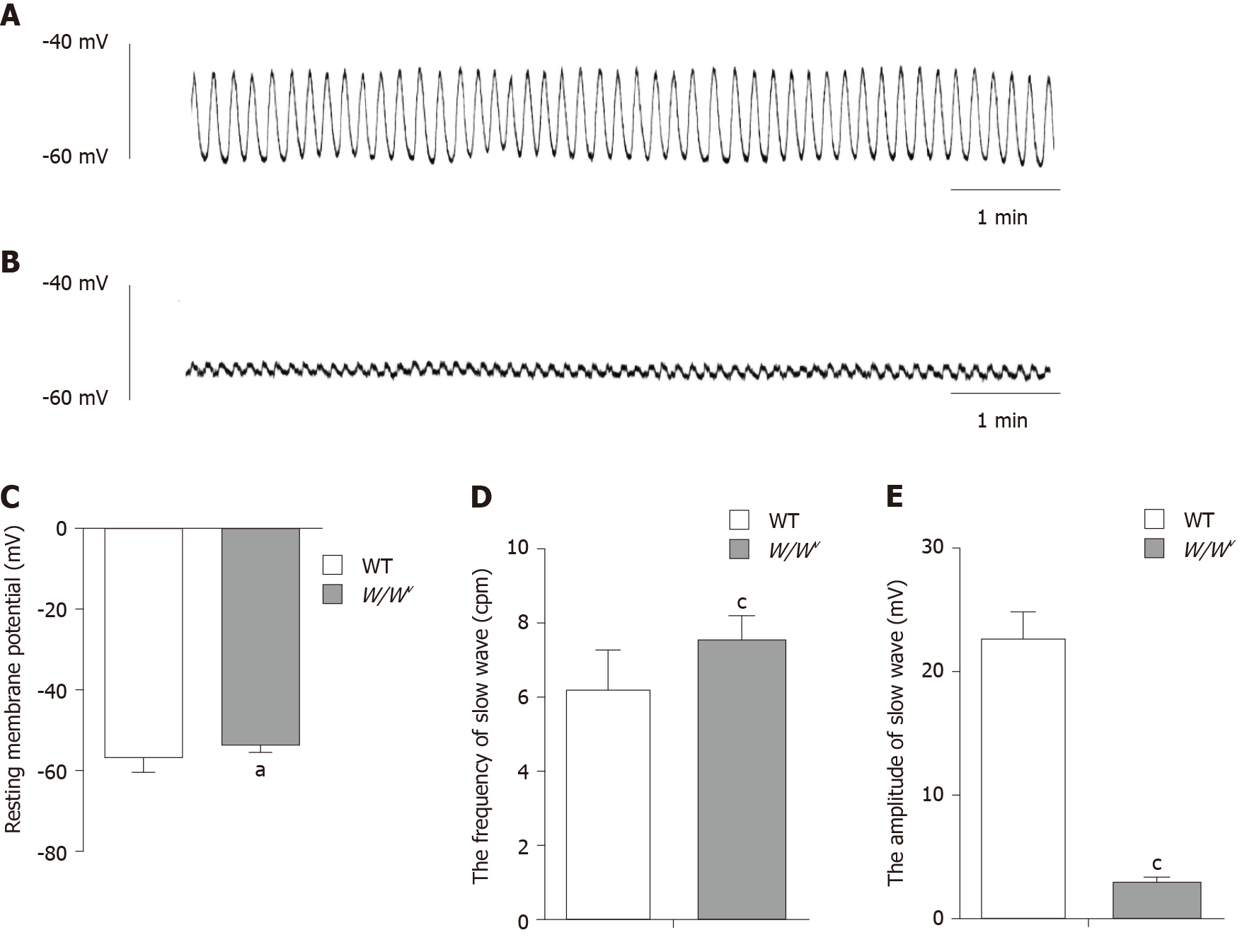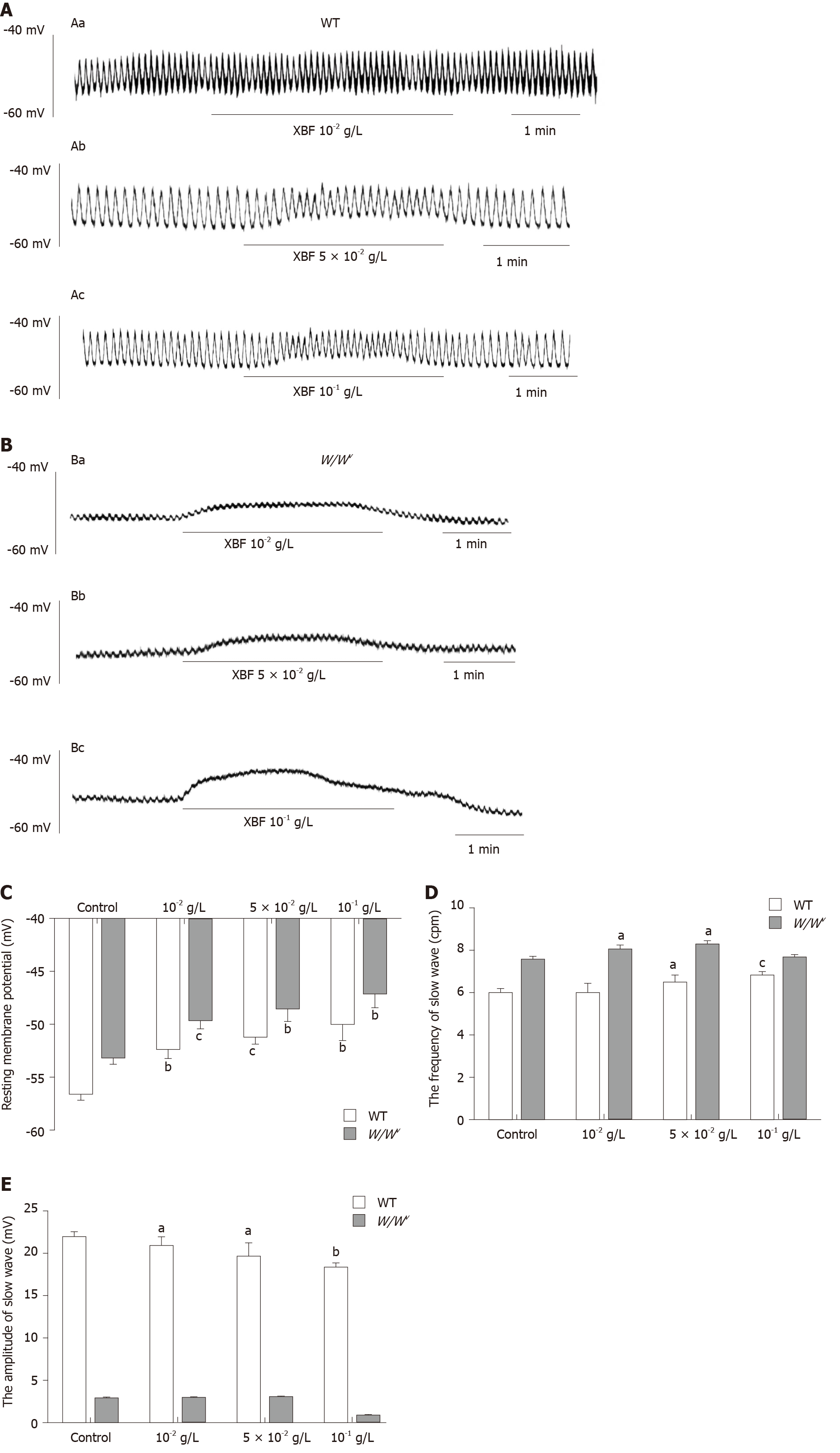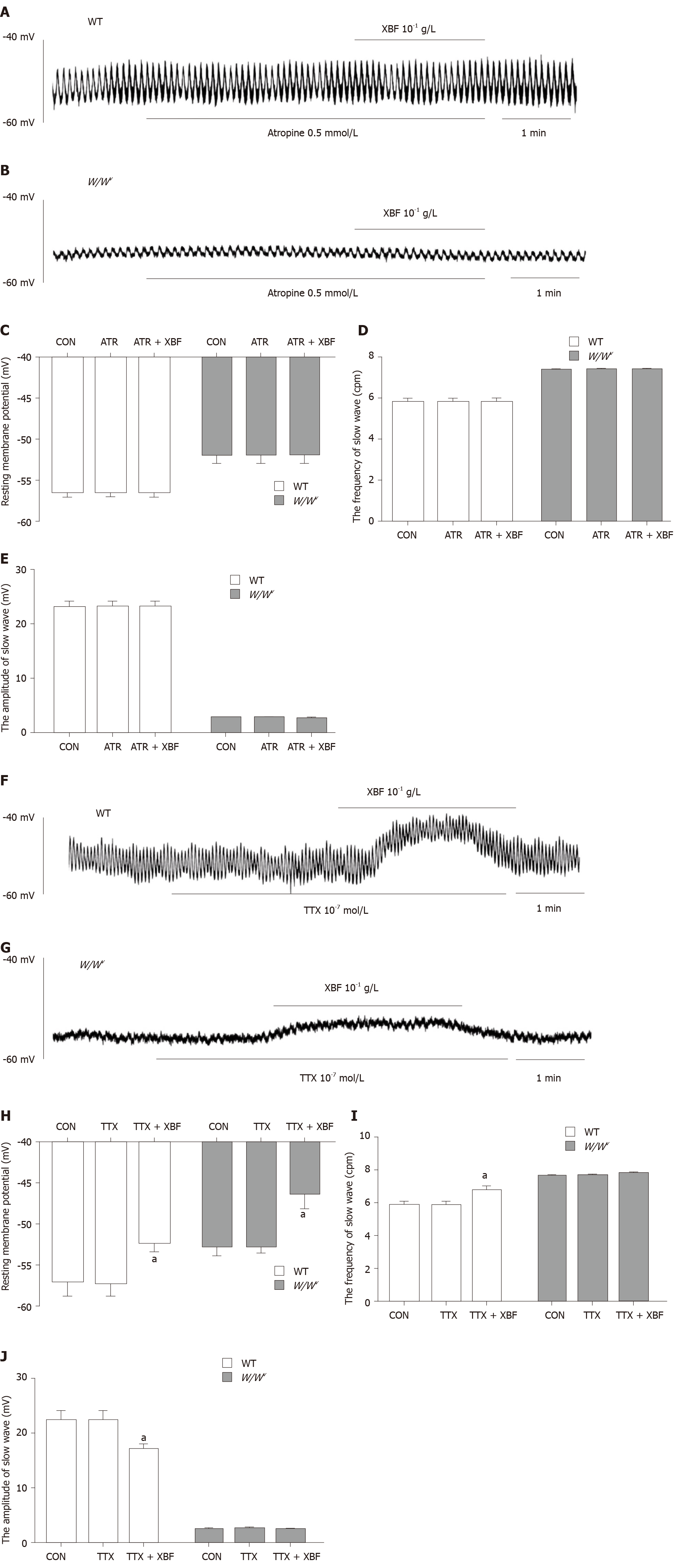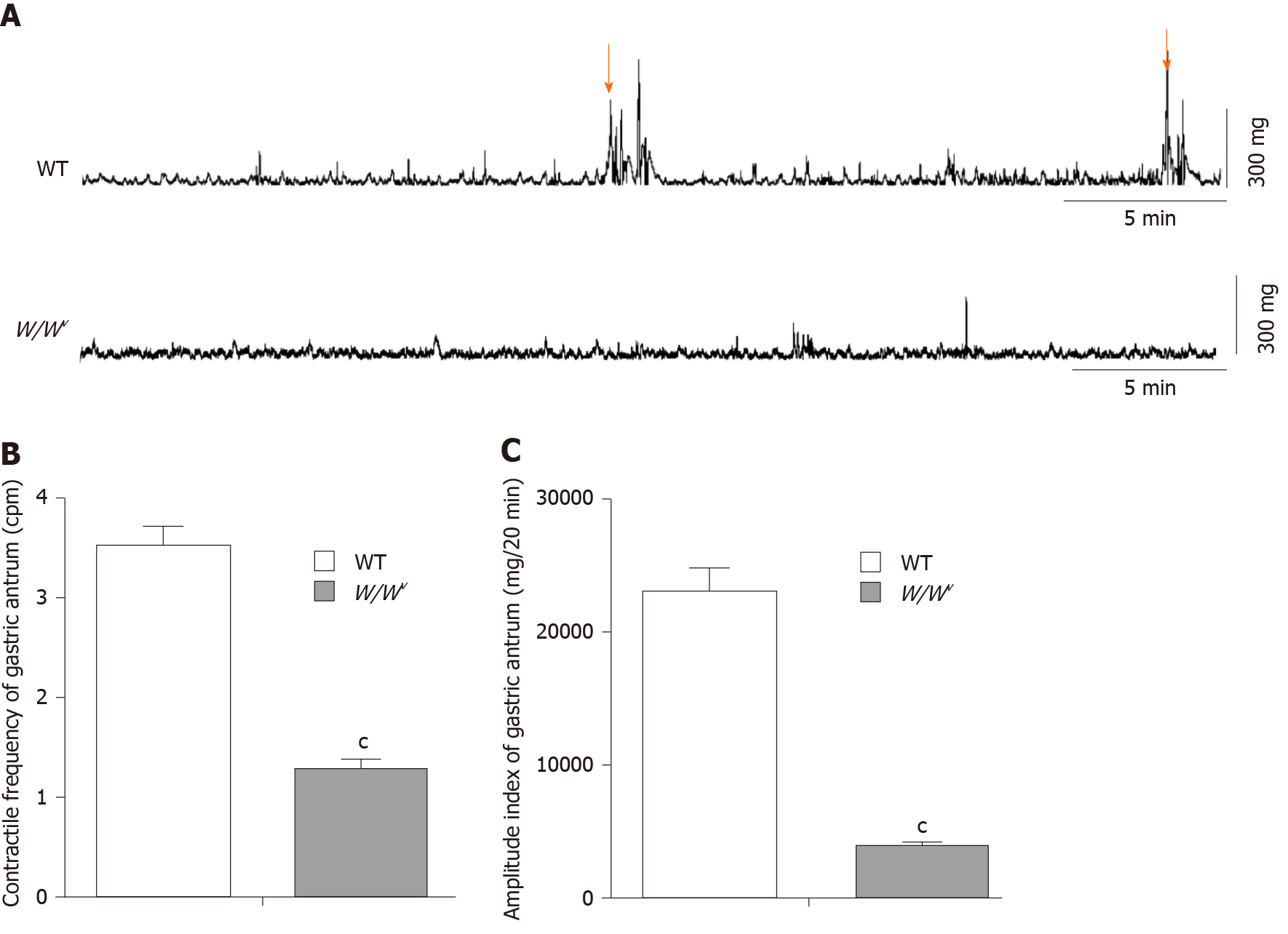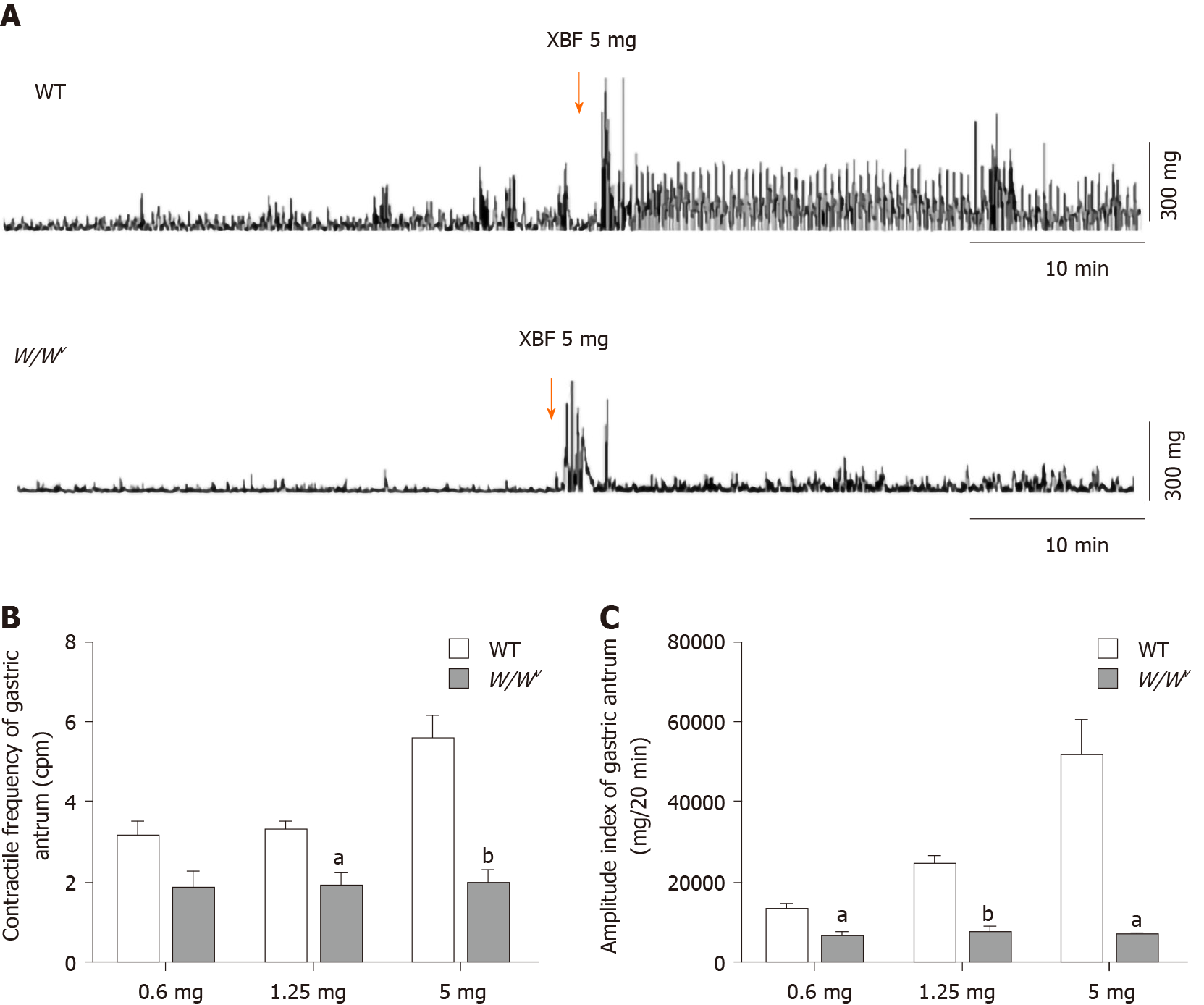Copyright
©The Author(s) 2021.
World J Gastroenterol. Feb 21, 2021; 27(7): 576-591
Published online Feb 21, 2021. doi: 10.3748/wjg.v27.i7.576
Published online Feb 21, 2021. doi: 10.3748/wjg.v27.i7.576
Figure 1 Immunogenicity of c-kit positive cells in the gastric antrum of wild-type and W/Wv mice.
The c-kit positive cells were observed under a confocal microscope. The unit volume was 424.3 µm × 424.3 µm × 6 µm ≈ 0.0011 mm3. A: Immunostaining images showing the networks of interstitial cells of Cajal myenteric plexus (ICC-MP) and intramuscular interstitial cells of Cajal (ICC-IM), respectively: The abundant c-kit positive ICC-MP network of gastric antrum in wild-type (WT) mice (Aa); the sparse c-kit positive ICC-MP network of the gastric antrum in W/Wv mice (Ab); c-kit positive ICC-IM network of the gastric antrum in WT mice (Ac); no ICC-IM network distribution in the antrum of W/Wv mice (Ad); B and C: The number of c-kit positive cells in ICC-MP and ICC-IM was compared in the gastric antrum of WT and W/Wv mice under unit volume (424.3 µm × 424.3 µm) (n = 10, cP < 0.001). ICC-MP: Interstitial cells of Cajal myenteric plexus; ICC-IM: Intramuscular interstitial cells of Cajal; WT: Wild-type.
Figure 2 Characteristics of the gastric antrum slow waves in wild-type and W/Wv mice.
A: Spontaneous rhythmic slow waves in the antrum of wild-type (WT) mice; B: Spontaneous rhythmic slow waves with the lower amplitude in the antrum of W/Wv mice; C-E: Comparison of resting membrane potential, frequency and amplitude of the gastric antrum slow waves between WT and W/Wv mice (n = 18, Welch’s t-test, aP < 0.05, cP < 0.0001). WT: Wild-type.
Figure 3 Effect of Xiangbinfang granule on gastric antrum slow wave in wild-type and W/Wv mice.
A: Representative trace of the effect of different concentrations of Champaign formula on gastric antrum slow waves in wild-type (WT) mice. After infusion of Xiangbinfang granule (XBF) at the concentration of 10-2 g/L (Aa), 5 × 10-2 g/L (Ab) and 10-1 g/L (Ac), the slow waves resting membrane potential (RMP) decreased, frequency increased and amplitude decreased; B: Representative trace of the effect of different concentrations of Champaign formula on gastric antrum slow waves in W/Wv mice. Infused XBF at the concentrations of 10-2 g/L (Ba), 5 × 10-2 g/L (Bb) and 10-1 g/L (Bc) decreased the RMP in W/Wv gastric antrum slow waves; C-E: Histogram of XBF for gastric slow wave RMP (C), frequency (D) and amplitude (E) in WT and W/Wv mice. (Control, n = 18; treatment, n = 6. Paired t-test was used to compare the difference before and after administration, aP < 0.05, bP < 0.001, cP < 0.0001). WT: Wild type; XBF: Xiangbinfang granule.
Figure 4 Effects of atropine and tetrodotoxin on the enhancement of gastric antrum slow wave by Xiangbinfang granule.
A and B: Representative trace of the effect of Xiangbinfang granule (XBF) 10-1 g/L on slow waves of the gastric antrum pretreated with atropine 5 mmol/L in wild-type (WT) (A) and W/Wv mice (B); C-G: Histogram of atropine blocking the effect of XBF on the enhancement of resting membrane potential (C), frequency (D) and amplitude (E) of antral slow waves. Representative trace of the effect of 10-1 g/L of XBF on slow waves of the gastric antrum pretreated with 10-7 M of tetrodotoxin (TTX) in WT (F) and W/Wv (G) mice; H-J: Histogram of TTX blocking the effect of XBF on the enhancement of the resting membrane potential (H), frequency (I) and amplitude (J) of antral slow waves. (Compared with pretreatment, n = 3, aP < 0.05). WT: Wild-type; XBF: Xiangbinfang granule; TTX: Tetrodotoxin; CON: Basic control; ATR: Atropine.
Figure 5 Characteristics of gastric antrum motility in conscious wild-type and W/Wv mice.
Micro strain-gauge force transducers were implanted into the gastric antrum to observe the migrating motor complex (MMC). A: Representative trace of the gastric antrum contractions in conscious wild-type (WT) and W/Wv mice. The black arrow shows the MMC III phase contraction; B and C: The histograms of the comparison of the contractile frequency (B) and amplitude index (C) of the gastric antrum in WT and W/Wv mice. (n = 8, Welch’s t-test, cP < 0.0001). WT: Wild-type.
Figure 6 Effect of Xiangbinfang granule on gastric antrum motility in wild-type and W/Wv mice.
A: Representative trace of the enhancement of the gastric antrum motility in wild-type (WT) and W/Wv by Xiangbinfang granule (XBF); B: Comparison of the antral contractile frequency of WT and W/Wv mice after intragastric administration of 0.6 mg, 1.25 mg and 5 mg XBF; C: Comparison of antral contractile amplitude index of WT and W/Wv mice after intragastric administration of 0.6 mg, 1.25 mg and 5 mg XBF (n = 8, Welch’s t-test, aP < 0.05, bP < 0.01). WT: Wild-type; XBF: Xiangbinfang granule.
Figure 7 Atropine and tetrodotoxin block the enhancement of antrum motility induced by Xiangbinfang granule.
A-D: Intraperitoneal injection of 0.1 mg/kg atropine (ATR) completely blocked the enhancement effect of Xiangbinfang granule (XBF, 5 mg) on gastric antrum in wild-type (WT) (A) and W/Wv (C) mice. Tetrodotoxin (TTX) partially reduced the gastric antrum motility enhancement mediated by XBF in WT (B) and W/Wv (D) mice; E-F: Comparison of the effect of XBF 5 mg of antral contractile amplitude index in WT and W/Wv mice after pretreatment with ATR 0.1 mg/kg (E) and TTX 0.05 mg/kg (F). (n = 4, Welch’s t-test, aP < 0.05, bP < 0.01, cP < 0.001). WT: Wild-type; XBF: Xiangbinfang granule; TTX: Tetrodotoxin; CON: Basic control; ATR: Atropine.
- Citation: Chen QC, Jiang Z, Zhang JH, Cao LX, Chen ZQ. Xiangbinfang granules enhance gastric antrum motility via intramuscular interstitial cells of Cajal in mice. World J Gastroenterol 2021; 27(7): 576-591
- URL: https://www.wjgnet.com/1007-9327/full/v27/i7/576.htm
- DOI: https://dx.doi.org/10.3748/wjg.v27.i7.576









